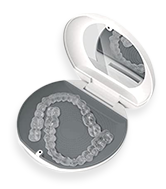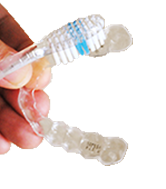
Have questions?
Let us answer them...
Your questions can be the same of many others, let us guide you to your relatable doubts..
- Home
- FAQ
- Frequently asked questions by Patients
- Aligner followups
Aligner followups
Whether you are thinking of starting aligner treatment or you have already started, you may be wondering how often you will need to see your dentist during the treatment. Although you do not have to visit your dentist as often as you would if you had braces, there are times when you will need to visit your dentist to ensure your treatment stays on track.
Aligner treatment differs for everyone depending on the dental issues that are being corrected, so the number of office visits will vary for each patient. In most cases, patients undergoing aligner treatment will usually have to visit their orthodontist every 4-6 weeks.
These follow up visits helps your orthodontist to check that your treatment is progressing as planned. While undergoing treatment with aligners, you will have to use a new set of aligners for every week or two. Each new set of aligners will make your teeth move closer to the proper position. With regular follow up visits, your orthodontist will have idea that the aligners are doing their job.
You may need to see your orthodontist for other issues apart from your scheduled follow up visits. For example, if you lose or break a set of aligners, you will need to visit your orthodontist so that he can provide you a replacement set of aligners or if needed you can move to a new set of aligners.
If attachments on your teeth falls off, in that case you should give a visit to your orthodontist.
Yes, you can go for aligners if your work profile is more about being social, attending meetings etc. the clear aligners are much less noticeable unlike braces where there is lot of metal framework which is easily visible.
As aligners are virtually not visible, you can feel confident in your look while wearing it. And one of the greatest advantages for such cases is that with aligners you require fewer dental visits that is after every 6-8 weeks which means there is no time lost for the appointment and less inconvenience for your busy schedule.
Also aligners can be easily removed, you can attend your meeting or conferences or have dinner after removing it and wear it back again.
Although attachments are only used in some of the cases, they are used to hold teeth in position and facilitate its movement.
Attachments are small tooth colored structures that are placed on your teeth during aligner treatment. They provide aligners a surface to push against and improve the tooth’s ability to move. They come in different shapes and sizes depending on cases. They are fabricated according to what type of force is to be applied to help teeth move or rotate without placing unnecessary pressure on the roots.
While your aligner treatment is still going on and if any of your attachment comes out, contact your orthodontist immediately and give a visit to clinic as you will have to get that attachment placed again on your teeth to ensure no break in treatment progress.
While visiting dental clinic you need to carry your previous set of aligner as it can act as a template for attachment placement.
Yes, you should carry previous set of aligners with you while visiting clinic for your follow up. This will help your orthodontist to keep the track of your treatment plan and review if treatment is going properly. After checking previous set, you will be told to switch to next set.
If there are still some corrections left to be done, then you might have to wear the same previous set for few more days to ensure proper teeth movement is obtained using that set of aligner and then you can switch to the next set.
obtained using that set of aligner and then you can switch to the next set.
Aligner treatment is generally less painful as compared to traditional braces, but some patients may experience some degree of pain or discomfort. Mostly it is felt when aligners are first fitted and when sets are changed after every 2 weeks. This is usually minor and subsides within few days once you get accustomed to it. Regardless of how long discomfort lasts, there are some ways you can reduce the discomfort and make treatment more comfortable.
Drink cold water:
Cold water can help reduce redness of gum tissue and provide relief. Also you need to keep in mind that you should avoid taking sugary or acidic drinks which can increase the risk of cavities in teeth.
Switch to new set during night time:
One way to deal with discomfort is to change to new set before going to bed. This will help your mouth to adjust during sleep so that pain is lessened during the day.
Smoothen out sharp or rough edges:
If you feel any sharp or rough edges on your aligners, contact your orthodontist make an appointment so that he/she will get it smoothen and irritation cause to tissues can be resolved once you start wearing it again.
If you feel your aligners doesn’t fit properly and there is space between your teeth and aligners, you can try doing following methods:
a) Insert the aligners and bite on chewie for 1-2 minutes at a time several times a day until aligner is seating properly. Chewies are small round rubber like pieces which when chewed helps sit your aligner properly in place.
b) If you have just started your aligner treatment, switch to previous set for another additional week and then wear the next set.
Zero stage aligners are trays made from material similar to those used for fabricating aligners. They are made according to patient’s teeth and is the first step before you start your aligner treatment. During this stage no force is applied on your teeth and is not meant for any tooth movement. This stage is to ensure that aligners fit properly on your teeth and you need to use it until you get accustomed to it and feel comfortable. It is also recommended that you should wear this set of aligners for 22 hours a day and for 2 weeks.
In very rare cases, this stage helps orthodontist to know if there is any allergic reaction developed after using it.
Nowadays aligners are preferred over traditional braces because it saves your time spent on follow ups. Usually regular follow up takes not more than 10-15 minutes, but in some cases during starting of treatment you might need trimming of some of your teeth for creating space or place attachments on teeth for aligners to hold a grip on your teeth and guide in proper tooth movement.
In such cases your follow up visit may take 30-45 minutes depending on your case. After this follow up visit every visit is scheduled after 6-8 weeks. Fewer follow up visits means less time lost for your appointments and less inconvenience for your busy schedules.
Don’t panic, as soon as you realize that you have missed your appointment, make sure you reschedule it. You don’t want to wait long to do this because your treatment is carefully planned to obtain maximum success with your treatment plan. By the time of follow up, keep wearing the same set of aligner for 22 hours a day so that the tooth movement which was done doesn’t get disturbed and teeth are maintained in their position. Wear them until your follow up is done and after consulting your orthodontist you can switch to the next set.
Teeth modification procedure are usually performed only on 1st follow up visit before starting aligner treatment. Those include:
IPR (interproximal reduction):
In this trimming of either left or right or both sides of teeth is performed so that space created is used for alignment of teeth.
Attachments:
These are small, round bumpy tooth colored structures that are placed on the teeth to guide aligners for movement of teeth. They come in different sizes and shape which depends on how the force is to be applied and differ from case to case.


